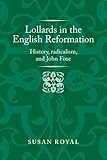Lollards in the English Reformation : history, radicalism, and John Foxe / Susan Royal.
Material type: TextSeries: Politics, culture, and society in early modern BritainPublisher: Manchester, UK : Manchester University Press, 2020Copyright date: ©2020Description: 1 online resource (256 pages) : file(s)Content type:
TextSeries: Politics, culture, and society in early modern BritainPublisher: Manchester, UK : Manchester University Press, 2020Copyright date: ©2020Description: 1 online resource (256 pages) : file(s)Content type: - 1526128810
- 9781526128812
- Foxe, John, 1516-1587 -- Influence
- Foxe, John, 1516-1587
- Lollards
- Reformation -- England
- Reformation -- Early movements -- Influence
- England -- Church history -- 16th century
- England -- Religion -- 16th century
- England -- Church history -- 17th century
- England -- Religion -- 17th century
- Lollards
- Réforme (Christianisme) -- Origines -- Influence
- Angleterre -- Histoire religieuse -- 16e siècle
- Angleterre -- Religion -- 16e siècle
- Angleterre -- Histoire religieuse -- 17e siècle
- Angleterre -- Religion -- 17e siècle
- Early Modern History: C 1450/1500 To C 1700
- HISTORY / Europe / Great Britain / Tudor & Elizabethan Era (1485-1603)
- Influence (Literary, artistic, etc.)
- Lollards
- Reformation
- Religion
- England
- Early Modern History
- European history: Reformation
- 1500-1699
- 274.206 23
- BX4901.3
- online - EBSCO
| Item type | Current library | Call number | URL | Status | Notes | Barcode | |
|---|---|---|---|---|---|---|---|
 eBook
eBook
|
Biblioteca "Angelicum" Pont. Univ. S.Tommaso d'Aquino Nuvola online | online - EBSCO (Browse shelf(Opens below)) | Online access | Not for loan (Accesso limitato) | Accesso per gli utenti autorizzati / Access for authorized users | (ebsco)3259263 |
Made available via: manchesterhive.
MUP 2020 titles.
Includes index.
Introduction -- 1. Lollards, evangelicals and historians -- 2. The Christian commonwealth -- 3. The lollard legacy of persecution -- 4. Sacraments -- 5. Priesthood and tithing -- 6. Preaching and conventicles -- Conclusions -- Index.
This book examines the afterlife of the lollard movement, demonstrating how it was shaped and used by evangelicals and seventeenth-century Protestants. It focuses on the work of John Foxe, whose influential <i>Acts and Monuments</i> (1563) reoriented the lollards from heretics and traitors to martyrs and model subjects, portraying them as Protestants' ideological forebears. It is a scholarly mainstay that Foxe edited radical lollard views to bring them in line with a mainstream monarchical church. But this book offers a strong corrective to the argument, revealing that the subversive material present in Foxe's text allowed seventeenth-century religious radicals to appropriate the lollards as historical validation of their own theological and political positions. The book argues that the same lollards who were used to strengthen the English church in the sixteenth century would play a role in its fragmentation in the seventeenth..
"This volume addresses a perennial question in the history of English religion: to what extent did the late-medieval dissenters known as lollards influence the Protestant Reformation? To answer this question, it examines the afterlife of the lollards as shaped by sixteenth-century evangelicals, especially John Foxe, and their seventeenth-century successors. Foxe's <i>Acts and Monuments</i> (1563) is second only to the Bible as the most influential book in early modern England, a juggernaut in Tudor historical writing that solidified the emergent national church. His reorientation of the lollards from heretics and traitors to martyrs and model subjects portrayed these medieval dissenters as Protestants' ideological forebears. This volume offers a strong corrective to the traditional interpretation that Foxe heavily edited radical Lollard views to bring them in line with a mainstream monarchical church. Instead, it shows that a wealth of non-mainstream material is present in Foxe's text that allowed seventeenth-century religious radicals to appropriate the lollards as historical validation of their own theological and political positions, including the act of separation.<i>Lollards in the English Reformation</i> traces the ensuing struggle for the Lollard legacy between conformists and nonconformists, arguing that the same lollards that Foxe used to bolster the fledgling English church in the sixteenth century would play a role in its fragmentation in the seventeenth. This fresh and exciting research promises to shake up our assumptions about Foxe, the levels of radicalism in post-Reformation Protestantism and the significance of historical precedent in post-Reformation polemic." -- Back cover.
Students and lecturers in early modern British religious history.
In English.
Description based on publisher's data


